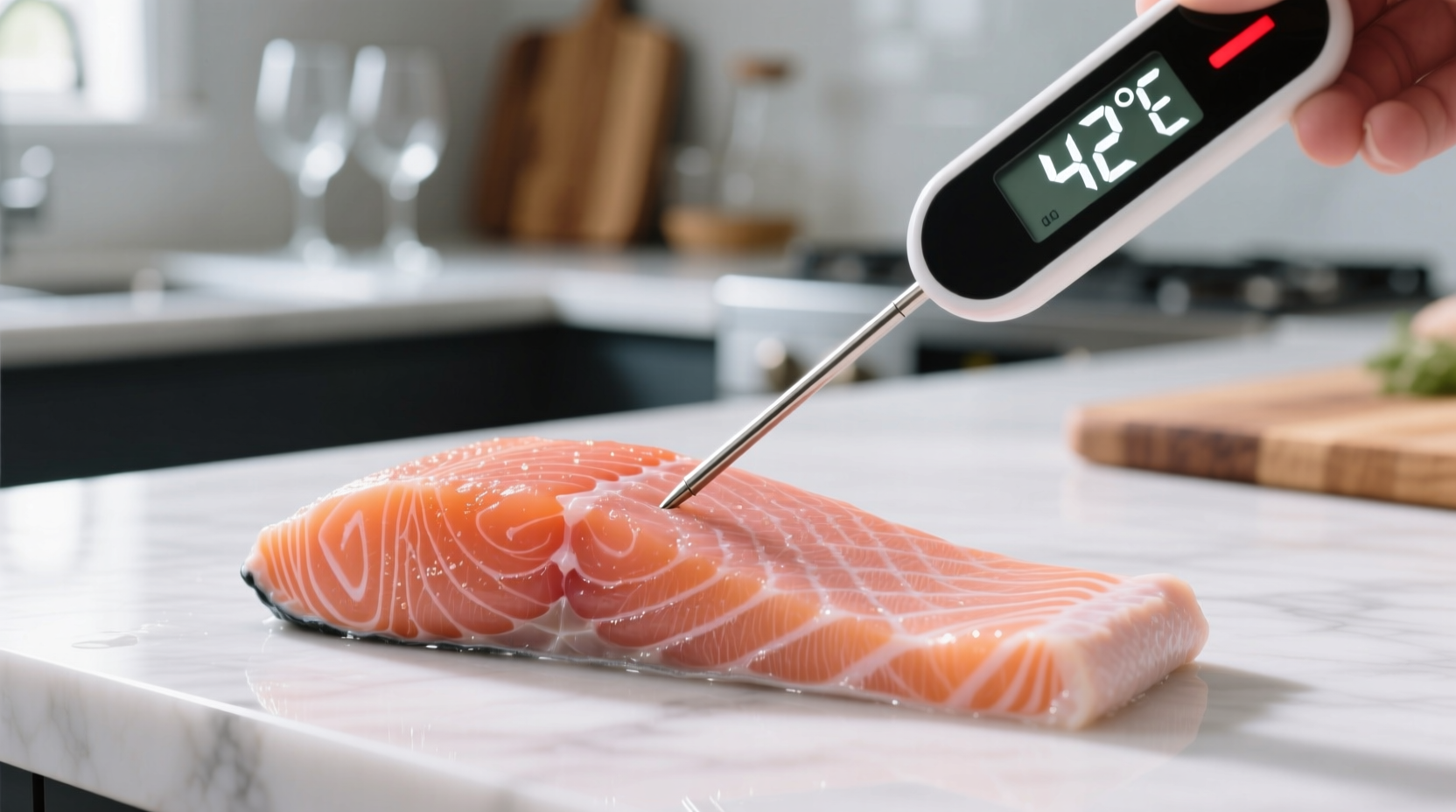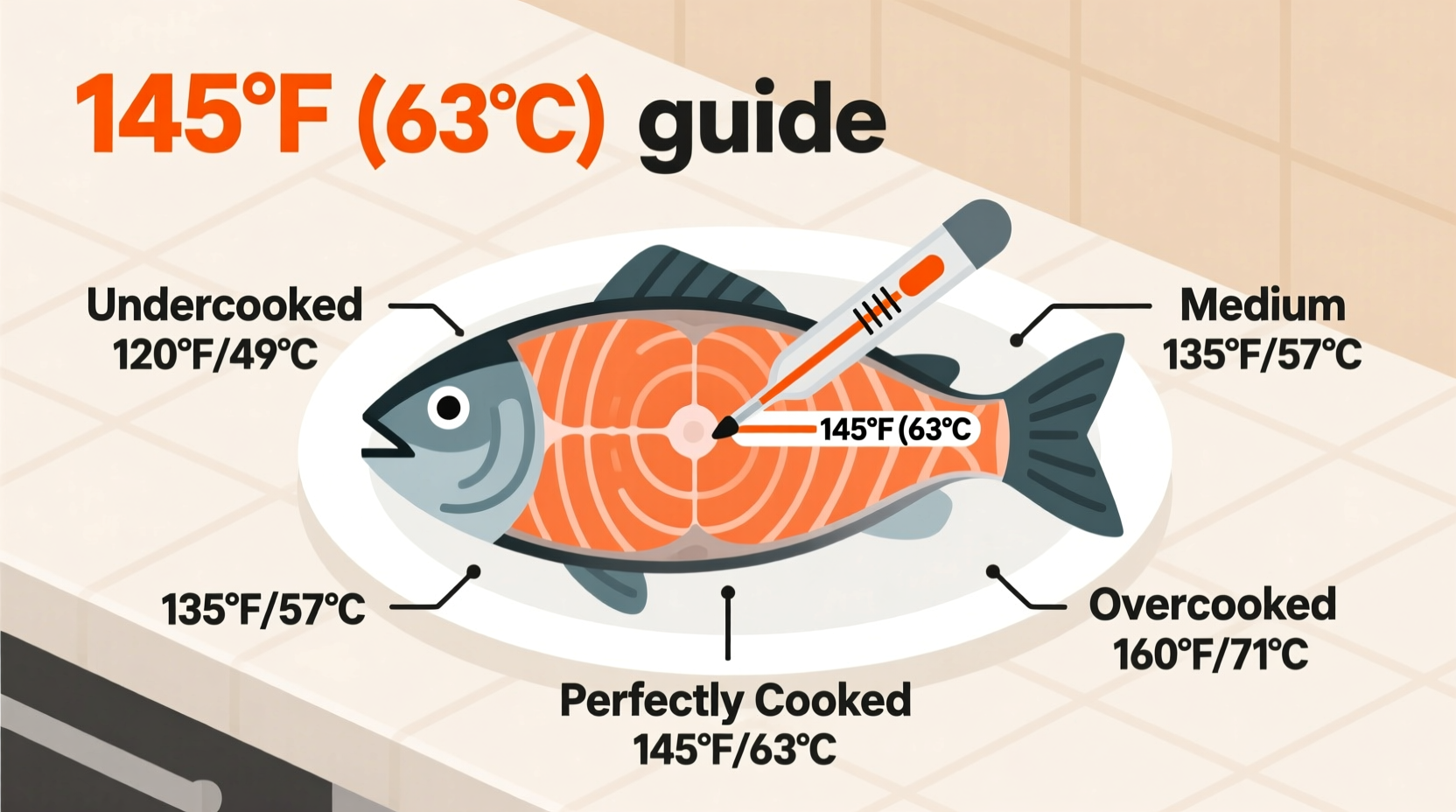Getting the cooking temperature right for fish isn't just about following rules—it's your guarantee of safe, delicious results every time. Whether you're preparing delicate sole or meaty salmon, understanding precise temperature requirements prevents foodborne illness while preserving that perfect flaky texture professional chefs achieve. This guide delivers science-backed temperature standards you can trust, complete with practical measurement techniques and visual indicators for when thermometers aren't available.
Why Fish Temperature Matters: Safety Meets Quality
Unlike poultry or ground meats, fish presents unique challenges. Undercooked fish can harbor dangerous pathogens like Vibrio and Listeria, while overcooked fish turns dry and rubbery within seconds. The 145°F (63°C) standard established by the USDA Food Safety and Inspection Service represents the critical threshold where:
- Harmful bacteria are effectively destroyed
- Proteins fully coagulate for safe consumption
- Muscle fibers retain optimal moisture
- Delicate omega-3 fatty acids remain intact
This temperature isn't arbitrary—it's based on decades of food science research documented in the FDA Food Code. For home cooks, it eliminates guesswork while providing a safety margin against common pathogens found in seafood.
Fish Cooking Temperature Reference Guide
Different fish varieties require slightly different approaches due to their fat content and muscle structure. This comprehensive temperature chart helps you navigate these variations:
| Fish Type | Recommended Temp | Visual Cues | Cooking Method Tips |
|---|---|---|---|
| Fatty fish (salmon, mackerel, trout) | 125-130°F (52-54°C) | Slightly translucent center | Remove from heat at 120°F for perfect medium-rare |
| Firm white fish (halibut, sea bass) | 135-140°F (57-60°C) | Flakes with light pressure | Check thickness—thicker cuts need full 140°F |
| Delicate fish (sole, flounder) | 140-145°F (60-63°C) | Opaque throughout | Cook quickly at high heat to prevent drying |
| Shellfish (shrimp, scallops) | 120-125°F (49-52°C) | Opaque and firm | Remove immediately when opaque—carryover cooking continues |
This chart reflects updated guidelines from the National Seafood Inspection Laboratory (NSIL), which recognizes that optimal temperatures vary based on fish composition. While the USDA maintains 145°F as the universal safety standard, culinary professionals often pull certain fatty fish types slightly below this mark for superior texture, relying on the carryover cooking effect during resting.
How to Accurately Measure Fish Temperature
Proper temperature measurement technique matters as much as the target temperature itself. Follow these professional methods:
- Choose the right thermometer: Use an instant-read digital thermometer (like Thermapen) for precision. The FDA recommends thermometers accurate to ±1°F.
- Insert correctly: Place the probe into the thickest part of the fish, avoiding bones which conduct heat differently.
- Check multiple spots: For larger fillets or whole fish, verify temperature in several locations as heat distribution varies.
- Time your measurement: Check during the final minute of cooking—fish temperature rises rapidly at the end stage.
- Account for carryover cooking: Fish continues cooking 5-10°F after removal from heat, so pull it slightly below target temperature.

When Thermometers Aren't Available: Reliable Visual Indicators
While thermometers provide the most accurate results, these visual cues serve as reliable alternatives when properly interpreted:
- Flake test: Gently press fish with fork—the flesh should separate easily along natural lines but remain moist
- Color change: Translucent raw fish becomes opaque throughout (note: some fatty fish like salmon retain slight translucency)
- Texture: Properly cooked fish offers slight resistance when pressed, then springs back
- Shrinkage: Fish typically shrinks about 20% when fully cooked
These indicators have evolved from traditional cooking methods documented by culinary historians. The University of California Sea Grant program confirms these visual tests correlate strongly with the 145°F safety threshold when properly executed.
Avoiding Common Temperature Mistakes
Even experienced cooks make these temperature-related errors:
- Mistake: Testing temperature too early
Solution: Wait until fish is nearly opaque before checking—frequent poking causes moisture loss - Mistake: Ignoring carryover cooking
Solution: Remove fish from heat 5°F below target temperature and let rest 5 minutes - Mistake: Using glass or dial thermometers
Solution: Upgrade to instant-read digital thermometers for accuracy within 1-2 seconds - Mistake: Not calibrating thermometers
Solution: Test in ice water (32°F/0°C) or boiling water (212°F/100°C at sea level) monthly
Special Considerations for Different Cooking Methods
Cooking technique affects temperature management:
- Grilling: High direct heat requires frequent temperature checks—remove at 135°F for carryover to 145°F
- Poaching: Maintain water at 160-180°F—fish reaches safe temperature without overcooking
- Sous vide: Precise temperature control allows cooking at lower temps (120-130°F) for extended periods
- Baking: Check temperature 5 minutes before recipe suggests—oven temperatures often vary
The American Culinary Federation notes that modern precision cooking methods have refined traditional temperature guidelines. While the 145°F standard remains essential for safety, understanding how different techniques interact with this benchmark allows for more nuanced results.
Food Safety Timeline: How Temperature Guidelines Evolved
Fish cooking recommendations have evolved significantly as food science advanced:
- Pre-1990s: Visual cues only—"cook until flaky" with no temperature standards
- 1993: USDA establishes first formal seafood safety guidelines after Vibrio outbreaks
- 2001: FDA Food Code adopts 145°F standard based on thermal death time research
- 2013: NSIL publishes species-specific temperature recommendations
- Present: Precision cooking techniques allow safe preparation at lower temperatures for certain methods
This progression reflects improved understanding of pathogen destruction temperatures. The current 145°F standard represents the point where Anisakis parasites (common in raw fish) are eliminated within seconds, according to FDA research.
When Different Temperatures Apply: Context Boundaries
Certain situations require temperature adjustments:
- Sushi-grade fish: Must be frozen at -4°F (-20°C) for 7 days to kill parasites before raw consumption
- Stuffed fish: Measure both fish and stuffing—stuffing must reach 165°F (74°C)
- Ceviche: Acid "cooks" fish but doesn't destroy parasites—use only previously frozen fish
- Smoked fish: Requires specific temperature protocols during smoking process
The National Oceanic and Atmospheric Administration (NOAA) emphasizes that these context boundaries exist because different preparation methods affect pathogen destruction differently. For standard cooking methods, 145°F remains the universal safety benchmark.
Practical Temperature Tips for Home Cooks
Implement these professional techniques immediately:
- Keep your thermometer in the fish during the final cooking minutes for continuous monitoring
- Use a thermometer with a 0.7mm probe tip for accurate readings in thin fillets
- Rest fish on a warm plate—not cold surfaces—to maintain proper carryover cooking
- For whole fish, check temperature behind the pectoral fin where meat is thickest
- Create a temperature log for your favorite recipes to refine cooking times
These practical tips transform temperature guidelines from abstract numbers into actionable cooking techniques. The University of Florida IFAS Extension confirms that consistent temperature monitoring reduces fish waste by 30% while improving food safety outcomes.











 浙公网安备
33010002000092号
浙公网安备
33010002000092号 浙B2-20120091-4
浙B2-20120091-4